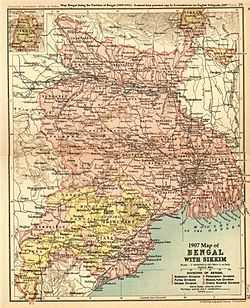Orissa famine of 1866

The Orissa famine of 1866 affected the east coast of India from Madras upwards, an area covering 180,000 miles and containing a population of 47,500,000; the impact of the famine, however, was greatest in Orissa, which at that time was quite isolated from the rest of India.[1]
Causes
Like all Indian famines of the 19th-century, the Orissa famine was preceded by a drought: the population of the region depended on the rice crop of the winter season for their sustenance; however, the monsoon of 1865 was scanty and stopped prematurely.[1] In addition, the Bengal Board of Revenue made incorrect estimates of the number of people who would need help and was misled by fictitious price lists. Consequently, as the food reserves began to dwindle, the gravity of the situation was not grasped until the end of May 1866, and by then the monsoons had set in.[1]
Course and relief
Efforts to ship the food to the isolated province were hampered because of bad weather, and when some shipments did reach the coast of Orissa, they could not be moved inland. The British Indian government imported some 10,000 tons of rice, which reached the affected population only in September.[1] Although many people died of starvation, more were killed by cholera before the monsoons and by malaria afterwards. In Orissa alone, at least 1 million people, a third of the population, died in 1866, and overall in the region approximately 4 to 5 million died in the two-year period.[1]
The heavy rains of 1866 also caused floods which destroyed the rice-crop in low-lying regions. Consequently, in the following year, another shortfall was expected, and the Government of British India imported approximately 40,000 tons of rice at four times the usual price.[1] However, this time they overestimated the need, and only half the rice was used by the time the summer monsoon of 1867, followed by a plentiful harvest, ended the famine in 1868. In the two years of the famine, the Government of British India spend approximately Rs.9,500,000 on famine relief for 35 million units (i.e. one person per day); a large proportion of the cost, however, was the high price of the imported grain.[1]
See also
- Timeline of major famines in India during British rule (1765 to 1947)
- Famines, Epidemics, and Public Health in the British Raj
- Company rule in India
- Famine in India
- Drought in India
Notes
References
- Ambirajan, S. (1976), "Malthusian Population Theory and Indian Famine Policy in the Nineteenth Century", Population Studies 30 (1): 5–14, doi:10.2307/2173660
- Arnold, David; Moore, R. I. (1991), Famine: Social Crisis and Historical Change (New Perspectives on the Past), Wiley-Blackwell. Pp. 164, ISBN 0-631-15119-2
- Bhatia, B. M. (1991), Famines in India: A Study in Some Aspects of the Economic History of India With Special Reference to Food Problem, 1860–1990, Stosius Inc/Advent Books Division, ISBN 81-220-0211-0
- Dutt, Romesh Chunder (2005) [1900], Open Letters to Lord Curzon on Famines and Land Assessments in India, London: Kegan Paul, Trench, Trubner & Co. Ltd (reprinted by Adamant Media Corporation), ISBN 1-4021-5115-2
- Dyson, Tim (1991), "On the Demography of South Asian Famines: Part I", Population Studies 45 (1): 5–25, doi:10.1080/0032472031000145056, JSTOR 2174991
- Dyson, Tim (1991), "On the Demography of South Asian Famines: Part II", Population Studies 45 (2): 279–297, doi:10.1080/0032472031000145446, JSTOR 2174784
- Dyson, Time (ed.) (1989), India's Historical Demography: Studies in Famine, Disease and Society, Riverdale, MD: The Riverdale Company. Pp. ix, 296
- Ghose, Ajit Kumar (1982), "Food Supply and Starvation: A Study of Famines with Reference to the Indian Subcontinent", Oxford Economic Papers, New Series 34 (2): 368–389, JSTOR 2662775
- Government of India (1867), Report of the Commissioners Appointed to Enquire into the Famine in Bengal and Orissa in 1866, Volumes I, II, Calcutta
- Government of India (1880), Report of the Indian Famine Commission, Part I, Calcutta
- Grada, Oscar O. (1997), "Markets and famines: A simple test with Indian data", Economic Letters 57: 241–244, doi:10.1016/S0165-1765(97)00228-0
- Hardiman, David (1996), "Usuary, Dearth and Famine in Western India", Past and Present 152 (1): 113–156, doi:10.1093/past/152.1.113
- Hill, Christopher V. (1991), "Philosophy and Reality in Riparian South Asia: British Famine Policy and Migration in Colonial North India", Modern Asian Studies 25 (2): 263–279, doi:10.1017/s0026749x00010672, JSTOR 312512
- Imperial Gazetteer of India vol. III (1907), The Indian Empire, Economic (Chapter X: Famine, pp. 475–502, Published under the authority of His Majesty's Secretary of State for India in Council, Oxford at the Clarendon Press. Pp. xxx, 1 map, 552.
- Klein, Ira (1973), "Death in India, 1871-1921", The Journal of Asian Studies 32 (4): 639–659, JSTOR 2052814
- McAlpin, Michelle B. (1983), "Famines, Epidemics, and Population Growth: The Case of India", Journal of Interdisciplinary History 14 (2): 351–366, JSTOR 203709
- McAlpin, Michelle B. (1979), "Dearth, Famine, and Risk: The Changing Impact of Crop Failures in Western India, 1870–1920", The Journal of Economic History 39 (1): 143–157, doi:10.1017/S0022050700096352, JSTOR 2118916
- Owen, Nicholas (2008), The British Left and India: Metropolitan Anti-Imperialism, 1885–1947 (Oxford Historical Monographs), Oxford: Oxford University Press. Pp. 300, ISBN 0-19-923301-2
- Sen, A. K. (1977), "Starvation and Exchange Entitlements: A General Approach and its Application to the Great Bengal Famine", Cambridge Journal of Economics 1 (1): 33–59
- Stone, Ian, Canal Irrigation in British India: Perspectives on Technological Change in a Peasant Economy, Cambridge South Asian Studies, Cambridge and London: Cambridge University Press, ISBN 0-521-52663-9